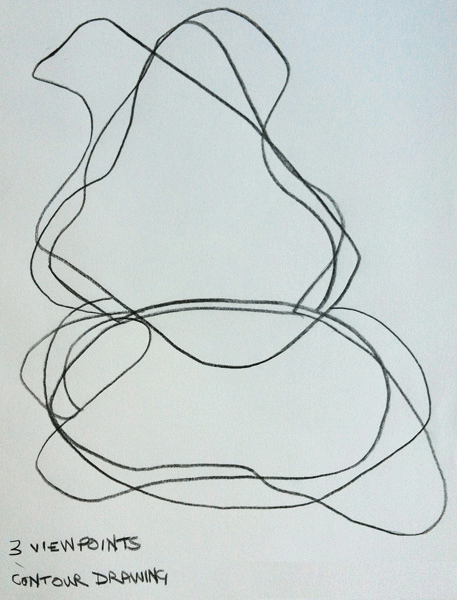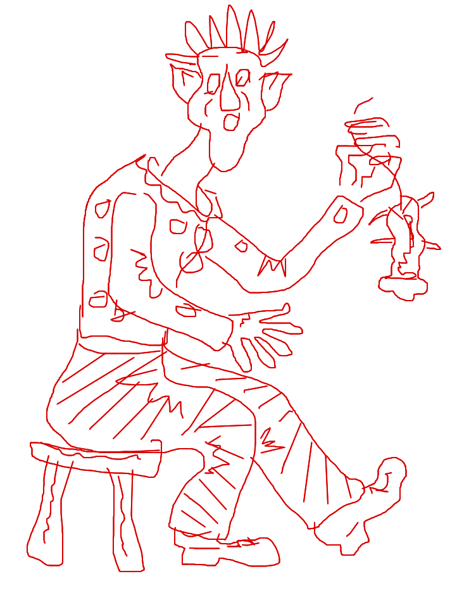Another demanding day at the Liverpool Tate for the 'Drawing the Line' course. Only achieved two pieces of work last Saturday, so today's post is not a photographic marathon. And not only that, I have to warn you that the second piece is even worse than the one above.
Our first project was to return to the 'Drawing the Century' exhibition gallery, armed with the A3 sketchbook and pencil, but this time we were to choose a sculpture and make a tonal drawing. In fact I used a thick graphite stick rather than a pencil.
Strangely enough we all seemed to gravitate to the Henry Moore sculpture, probably because the lighting and the varied shapes created good shadows.
Same picture, different light when I photographed it.
I chose this viewpoint, from the 'feet' end I suppose you could say - at least it's the end opposite the head. I liked this because the receding shapes of the carving looked like hills and valleys.
I've NEVER been good at tonal work, as you can see from the photograph above. It's partly sheer laziness. I don't have the patience to continue shading in one image instead of drawing a few images with line, which is probably why I tend to use avoidance tactics on tonal work.
So we all spent the next hour in deep concentration, not a word passed between any of us, and gallery visitors walked by without a word of complaint that they couldn't get anywhere near the sculpture.
Stephen Ashton, our course leader, walked around from time to time, but made only the odd comment to one or two of the group. I was pleased with the result, but mainly because I had made myself sit for an hour to do it, and it did have a vague resemblance to the sculpture.
Now this is where things get even worse. Our task back in the studio was to use charcoal - cover the whole of an A1 piece of card with the charcoal stick, then use an eraser to carve out an image of what we had drawn.
I HATE DRAWING WITH CHARCOAL.
I opted out of the charcoal on three grounds:
(1) I don't like getting my hands covered in black charcoal,
(2) I didn't have an art apron and didn't want my clothes covered in black dust, and
(3) the dust would cause me to have problems with asthma.
Good thinking, Jez.
Stephen didn't even blink. He said 'OK' and took me up to the exhibition gallery again to look at something I could do with different materials.
He chose a drawing by Frank Auerbach, on which the artist had worked so much and so fiercely that the paper was worn through in one part and he had stuck a new piece over the hole, and in other places he had even torn the paper.
Stephen suggested that I might like to try something similar based on my tonal sketch. That sounded like fun, and the next photo shows what emerged after another hour of concentrated work.
Not a pretty sight, and definitely 'inspired by' and 'derived from' my drawing. I chose to paint an outline of just part of my drawing with brush and black ink .
Then I worked on it, and worked on it, with the graphite stick, black ink and red acrylic paint. I used a large brush to slop the ink and paint around.
I scrubbed at the wet ink and paint with damp kitchen towel, slopped water on and scrubbed it in with kitchen towel,
rubbed hard at areas with an eraser,
scratched hard into it with the brush end,
scratched and stabbed with scissors.
Never worked like that before. All without conscious direction.
This selection of part of the image shows a little more clearly the scratching marks of the scissors and the holes in the head.
I knew that I had ruined the paper so much that there would be some effect on the reverse, even though the paper was quite a high gsm.
The reverse shows more clearly the holes, and the scribbles scratched in with the scissors.
The some of the ink and paint had even leaked through to the next page. Stephen made the comment that the images were talking to each other.
I apologised to him for not doing the activity he had planned for us. He said "It doesn't bother me, does it bother you?" "No, I'm happy to have done something so different and learnt from it".
I was pleased with it. He was pleased with it. What a great tutor!
Last morning of the course on Saturday. Can't wait.




















































